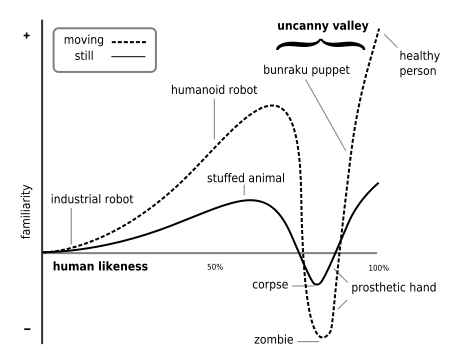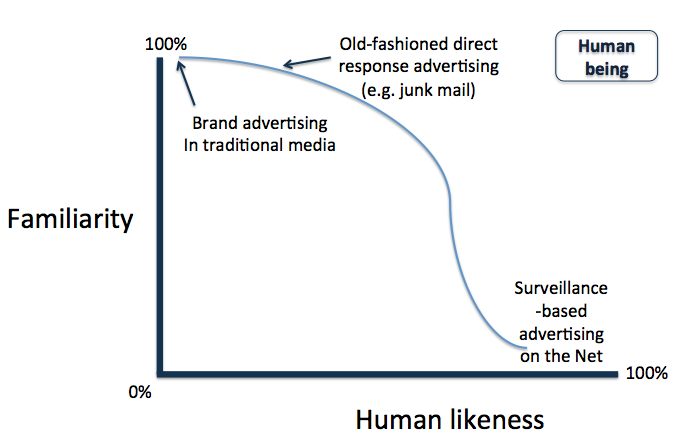The uncanny valley is where you find likenesses of live humans that are just real enough to be creepy. On a graph it looks like this:

So I was thinking about how this looks for advertising that wants to get perfectly personal. You know: advertising that comes from systems that know you better than you know yourself, so they can give you messages that are perfectly personalized, all the time. I think it might look like this:

Traditional brand advertising — the kind we see in print, hear on radio and watch on TV — is fully familiar, but not at all human. It comes from companies, by way of media that also aren’t human. A little less familiar, but slightly more human, is old fashioned direct response advertising, such as junk mail. The messages might be addressed to us personally, and human in that respect, but still lacking in human likeness. Avertising that gets highly personal with us, because it’s based on surveillance-fed big data and super-smart algorithms, is much less familiar than the first two types, yet much more human-like. Yet it’s not really human, and we know that. Mostly it’s just creepy, because it’s clearly based on knowing more about us than we feel comfortable having it know. And it’s only one kind of human: a salesperson who thinks we’re ready to buy something, all the time — or can at least be influenced in some way.
I’m just thinking and drawing out loud here, and don’t offer this as a final analysis. Mostly I’m metabolizing what I’m learning from Don Marti‘s thinking out loud about these very different kinds of advertising, and how well they actually work, or don’t — for advertisers, for the media they support, and for the human targets themselves. (Like Don I also dig Bob Hoffman’s Ad Contrarian.)
So there ya go. I welcome your thoughts.
[Later…] I was just reminded of T.Rob‘s excellent Escaping Advertising’s Uncanny Valley and Sara Watson’s pieces cited below (she’s a Berkman Center colleague):
- Colin Strong: Are brands entering an uncanny valley? and Is the marriage of big data and advertising headed for an ‘uncanny valley’?
- Sara M. Watson: The Uncanny Valley of Targeted Marketing, The Uncanny Valley of Personalization and When big data falls into the uncanny valley
- Alex Bramwell in Linkedin: The Uncanny Valley and why big data marketers are headed for it
- @FelixSalmon in Wired: The Uncanny Valley of Advertising
- Farhad Manjoo in Slate: The Uncanny Valley of Internet Advertising — Targeted Web ads are too dumb to be useful and just smart enough to make you queasy.
- Mike Masnick in Innovation: Getting past the uncanny valley in targeted advertising
- Helen Beckett in BVEX: Uncanny Valley: Deadly Destination of OTT Digital Marketer
- Paul McEwan in TribalYell: The uncanny valley of interactive advertising
What we see here is a groundswell of agreement about what’s going on. But do we see a reversal in the marketplace? Maybe we will if @rwang0 is right when he tweets “2015 is not the year of the crowd, it’s the year when the crowd realizes they are the product and they don’t like it.”
Leave a Reply